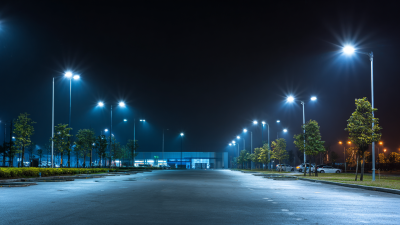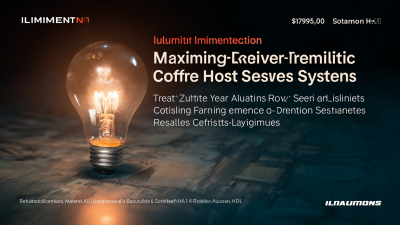How to Select the Best Industrial Led Lighting for Your Facility Needs
Selecting the optimal Industrial LED Lighting for your facility is crucial for enhancing operational efficiency and reducing energy expenses. According to a report by the U.S. Department of Energy, lighting accounts for approximately 25% of a facility's electricity use, with industrial sectors often experiencing even higher costs. Transitioning to LED technology can lead to energy savings of up to 75%, while also providing improved illumination quality, which can significantly boost employee productivity and safety. With the market for LED lighting in industrial applications projected to grow at a CAGR of 14.5% from 2021 to 2028, understanding how to choose the right lighting solutions tailored to specific needs is paramount. In this guide, we will explore essential factors to consider when selecting Industrial LED Lighting that aligns with your facility's requirements and industry standards.

Understanding Your Facility's Specific Lighting Requirements
 Understanding your facility's specific lighting requirements is crucial for selecting the best industrial LED lighting. Every facility has unique needs based on its layout, operations, and the type of work being performed. For example, a manufacturing plant may require high-bay lighting to illuminate large spaces, while a warehouse may benefit from motion sensor lights to enhance energy efficiency. Assessing the size, shape, and purpose of each area will help determine the appropriate brightness levels, color temperatures, and fixture types.
Understanding your facility's specific lighting requirements is crucial for selecting the best industrial LED lighting. Every facility has unique needs based on its layout, operations, and the type of work being performed. For example, a manufacturing plant may require high-bay lighting to illuminate large spaces, while a warehouse may benefit from motion sensor lights to enhance energy efficiency. Assessing the size, shape, and purpose of each area will help determine the appropriate brightness levels, color temperatures, and fixture types.
**Tips:** When evaluating your lighting needs, start by conducting a thorough assessment of each space in your facility. Take note of the tasks performed in each area and the desired visibility. Consider consulting with lighting professionals who can provide specialized insights tailored to your operational requirements.
In addition, consider the energy efficiency of the LED fixtures. Not only do industrial LEDs provide better lighting quality, but they also consume less energy and have a longer lifespan compared to traditional lighting. Tips: Look for products that have an Energy Star certification or similar energy efficiency ratings. This will not only reduce operational costs but also minimize downtime and maintenance needs, ultimately leading to a safer and more productive work environment.
Evaluating Different Types of Industrial LED Lighting Options
When evaluating different types of industrial LED lighting options for your facility, it’s essential to consider the specific needs of your environment. According to the American Lighting Association, industrial LED lights can offer energy savings of approximately 50-70% compared to traditional lighting systems. This reduction not only lowers utility costs but also minimizes the frequency of light replacements, contributing to long-term savings.
Different types of LED lighting fixtures, such as high bay lights, low bay lights, and floodlights, cater to varying height and spatial requirements. For instance, high bay lights are ideal for warehouses and manufacturing spaces with ceilings taller than 20 feet, providing robust illumination with minimal glare. Meanwhile, floodlights can be especially effective for outdoor areas, ensuring safety while maximizing visibility. A report from the Department of Energy states that switching to LED technology can reduce greenhouse gas emissions by nearly 1.5 billion metric tons over a 20-year period, highlighting the environmental benefits of these advanced lighting options. Understanding the advantages and suitability of these diverse LED lighting types is crucial in making an informed choice that aligns with operational efficiency and sustainability goals.

Key Features to Look for in Industrial LED Fixtures
When selecting industrial LED lighting for your facility, it’s crucial to focus on key features that enhance efficiency and safety. High lumen output is vital, as it directly affects visibility in production and storage areas. Many reports indicate that LED fixtures with a lumen output of over 130 lumens per watt can significantly reduce energy consumption while providing optimal illumination. Additionally, look for options that offer adjustable beam angles and color temperatures to accommodate various tasks, which can optimize both worker comfort and productivity.
Durability is another essential feature, especially in industrial environments where fixtures are exposed to harsh conditions. Selecting LED lights with high IP ratings (ingress protection) ensures resistance to dust and moisture, extending their lifespan. A study showed that rugged lighting solutions can last 50,000 hours or more, drastically reducing maintenance costs over time. Furthermore, integrating connected lighting technology allows for smart controls and energy management, enabling facilities to monitor usage patterns and optimize performance, aligning with sustainability goals in an industry responsible for a significant percentage of greenhouse gas emissions.
How to Select the Best Industrial Led Lighting for Your Facility Needs - Key Features to Look for in Industrial LED Fixtures
| Feature | Importance | Recommended Value |
|---|---|---|
| Lumens Output | Brightness Level | At least 10,000 lumens for large spaces |
| Color Temperature | Affects visibility and ambiance | 4000K to 5000K for industrial use |
| Energy Efficiency | Impacts operating costs | Minimum 100 lumens per watt |
| Durability Rating | Resistance to environmental factors | IP65 or higher for wet locations |
| Lifespan | Frequency of replacement | 50,000 hours or more |
| Beam Angle | Coverage area of light | 60° to 120° for general lighting |
| Dimming Capability | Flexibility in light levels | Dimmable options preferred |
| Warranty | Assurance on product quality | At least 5 years |
Assessing Energy Efficiency and Cost Savings
When selecting industrial LED lighting, assessing energy efficiency and cost savings should be a primary concern. According to a report by the U.S. Department of Energy, LED lighting uses at least 75% less energy than traditional incandescent lighting, leading to substantial reductions in energy bills. For facilities that operate 24/7, this can result in significant savings over time. Moreover, with a longer lifespan of up to 50,000 hours compared to 1,000 hours for incandescent bulbs, LED lighting minimizes not only replacement costs but also maintenance expenses.
**Tip:** Conduct an energy audit of your facility to identify areas where lighting can be improved, and calculate potential savings. Pairing LED lights with smart technology, like motion sensors, can further enhance energy efficiency by ensuring lights are only on when needed.
Investing in quality LED fixtures can also yield considerable financial benefits. The initial investment might be higher, but incentives such as rebates from utility companies can offset these costs. Studies have revealed that when accounting for energy savings and incentives, many businesses recoup their LED investment within 2-3 years.
**Tip:** Stay updated on local utility incentives and rebates for upgrading to energy-efficient lighting. Properly researching these programs can provide additional budget relief, making the transition to LEDs even more attractive for your facility.
Energy Efficiency Comparison of Industrial LED Lighting
This chart illustrates the energy efficiency (in lumens per watt) of different industrial LED lighting options while also indicating their respective cost savings over time. The data highlights the performance of various LED types to aid in selecting the best option for your facility needs.
Choosing the Right Lighting Controls and Accessories for Your Facility
When selecting the best industrial LED lighting for your facility, it's crucial to consider not only the lights themselves but also the accompanying controls and accessories. The right lighting controls can greatly enhance energy efficiency and improve the overall functionality of your lighting system. For instance, incorporating smart controls such as motion sensors, timers, and dimmers allows you to optimize light levels based on occupancy and daylight availability. This not only reduces energy consumption but also extends the lifespan of your lighting fixtures.
Furthermore, the choice of accessories can significantly impact the performance and safety of your lighting setup. Accessories such as protective guards, lenses, and reflectors can help meet specific operational requirements while ensuring a safe working environment. Additionally, using accessories designed for specific tasks, such as high-bay fixtures for warehouses or explosion-proof fixtures for hazardous areas, ensures compliance with industry standards. By thoughtfully integrating the right controls and accessories, you can maximize the benefits of your LED lighting investment, ultimately enhancing productivity and safety within your facility.
Related Posts
-

Navigating the 2025 Trends in Lighting Technology with the Best Led Fixtures for Your Business
-

World Class Chinese Manufacturing for Your Ultimate Commercial Lighting Supply Needs
-

Solutions for Optimal Commercial Lighting Innovations
-

Unleashing Innovation: Unique LED Luminaires Designs for Modern Spaces
-

How to Identify Quality Manufacturers for Best Security Lighting: Key Industry Insights and Data
-

Maximizing Your Investment: How Excellent After-Sales Service Reduces Repair Costs for Best Illumination Lighting Systems
